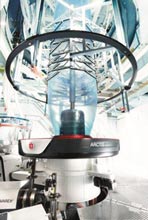
German extrusion machine maker Windmöller & Hölscher (W&H) kept its latest line tightly under wraps and simply called it the E-24 before the K show. Even at the show, visitors had to go through a tunnel-like entrance to view the line on display.
So what is this technology that warrants such secrecy? According to company spokesperson Elisabeth Braumann, "The new blown film line is one of the most important developments in our history. We have been developing it since the K2010 and have upgraded all the components to allow for more flexibility, a sustainable production, higher output, and improvements to the quality of the film." She said that the new blown film line Varex II will replace the Varex I. "It has a new die and air ring and looks much more neater since all the components, like the extruders, are covered."
The firm says that using the well-known and proven Varex technology as a foundation it has improved upon the concept to feature Varex II. It is modularly designed and can be tailored to a user's specific requirements. This concept also allows for retrofitting with optional modules and new technologies to accommodate future requirements, when the need arises. All the components are also integrated in a central control system for ease of operation and monitoring from an ergonomically designed and intuitive operating unit.
Highlights include the Maxicone P die specially optimised for polyolefins, flow-optimised barrier screws, patented melt distribution system, Optifil P gauge profile control system, new bubble collapsing unit in the film haul-off, new Filmatic S II winder and the new Arctis air ring, which is an upgrade of the Opticool air ring presented in 2009.
The Varex II is available with working widths up to 3,600 mm and for up to 11-layer films. It is designed for outputs up to 1,500 kg/hour. Extruder sizes include 50, 60, 70, 90, 105, 120 and 135.30 D. Die diameters range from 120 to 900 mm.
At the K it was shown running a five-layer, 2,200 mm, 40-micron collation shrink film based on ExxonMobil Chemical’s Exceed and Enable metallocene polyethylene (mPE) resins. According to the US chemicals firm, compared to conventional three-layer PE films, converters can benefit from higher productivity and greater flexibility to produce a broader range of film solutions from a single line.
Dirk Van der Sanden, Global Processing and Converting Advisor, polyolefins technology, ExxonMobil Chemical says that the performance opportunities for five-layer films "are huge, open new market opportunities, providing greater potential for a faster return on investment." He also says that the additional two layers in the film structure allow the optical and performance properties to be tailored to meet the needs of the application. To achieve similar flexibility with three-layer technology would possibly require two lines that could be more expensive to buy and to operate, he adds.
The concept of five-layer technology for dedicated polyolefin blown films was first introduced at K2010. Today, this technology has advanced considerably as several customers are currently finalising formulations for commercial applications.
(PRA)
















